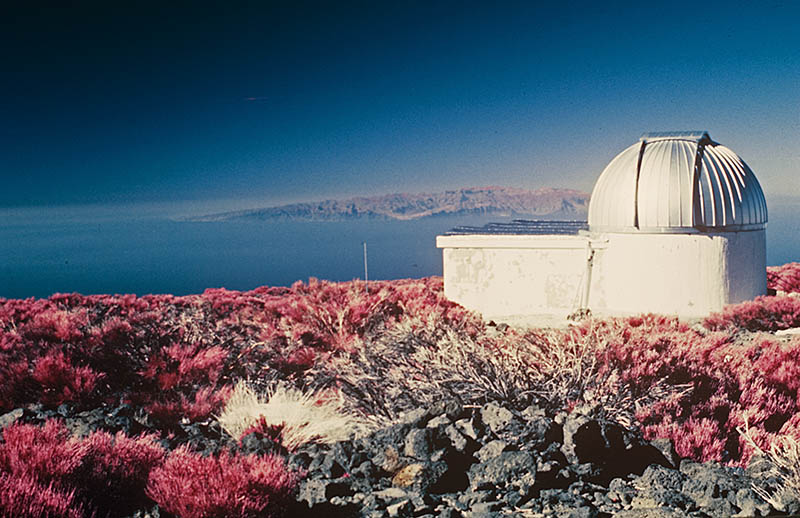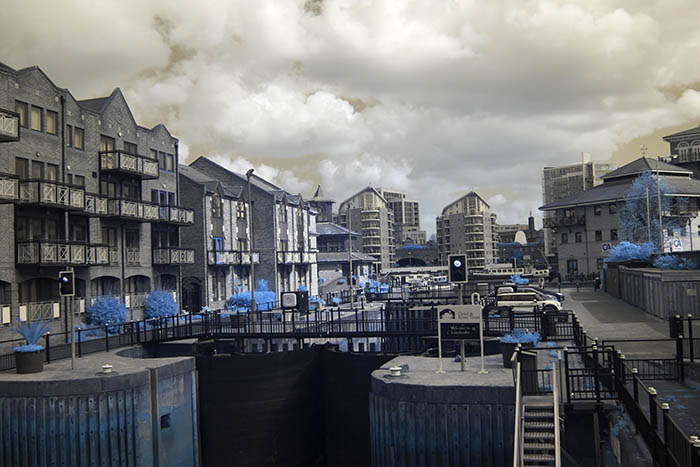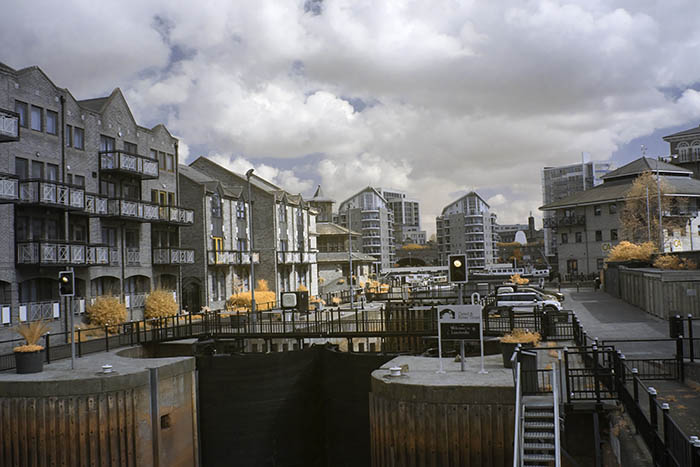Infra-red photographs
You may have noticed a theme in the photographs and descriptions on this site; namely that some places seem to be a bit bigger than real, or stranger. I'm a science fiction fan, and I have a Physics background. Science fiction has the same view; there is more, or will be more, than just the mundane present. Physics can't explain 97% of the observable universe so it agrees. I take photographs with the same view so I am always looking for ways to express this. To this end I thought I would get back into infra-red or IR photography.
Infra-red is the region beyond the red end of the visible spectrum. Years ago in the age of film both monochrome and colour IR film was produced. These are now long gone.

The above is a photograph I took thirty years ago. The technique obviously has possibilities, but the film is no longer available. With film one only needs to use the IR film with no camera modifications. It was quite difficult to get the chemistry of IR film to work, and the film did not keep well. It had to be sensitive to low energy IR photons, so was sensitive to heat. Modern digital cameras have a completely different set of problems. The sensors used actually have peak sensitivity in the near IR. If allowed to go unchecked this would wreck the colour balance of images. Equal sensitivity to red, green and blue is needed to match human vision. For this reason an IR cut filter is placed over the sensor. It is just possible to take IR photos with an unmodified camera, but the sensitivity to IR is about 15 stops worse than using a modified camera. There is little alternative to using a modified camera which will then be of little use for normal photography.
I had a Sony A6000 camera modified by Alan Burch at:
https://www.infraredcameraconversions.co.ukThe conversion went smoothly and the camera operates normally except where it attempts to do it's own color temperature readings. This prevents use of the most automatic two settings available but still leaves programmed, aperture priority etc. If the camera is used in this state it will work as normal, but with poor colour fidelity. To get the effect of IR you need to cut off some or all of visible light coming into the camera. Typically a filter which only allows wavelength of more than 720nm is used. To the human eye this filter is black and does not let any visible light through. If everything worked perfectly one would get no colour in the resulting images because only the red sensors would record any light. In practice the green and blue sensors do record some signal so that there is some residual colour in the image and by using the custom white balance on the camera one gets an image in the viewfinder similar to the image below.

The sky takes on a brownish yellow tinge and foliage is bright blue, in stark contrast to IR film where the foliage is red. The photograph was taken with a 680nm filter which lets in a little visible so the colours are quite strong. By switching the red and blue channels one gets the picture below.

This has the effect of making the sky blue and the foliage yellow, which is a little more natural. In general I don't like this look; especially with a 720nm or even longer IR filter. I like the look of the unswapped images which remind me of sepia toning, but with a bit more colour interest. I will be using the unswapped images by default in future or maybe going to monochrome in some cases.
Lenses with IR
The only major problem I have had is with using standard lenses. Most camera lenses are of course designed to work over the visible wavelength range. using them at the "wrong" wavelength is a little unfair on their designers. There are two major effects. The lens may not be as sharp as it is in the visible spectrum. This has not caused me any problems as yet. Most of my pictures have pixels to spare. The other problem is that anti-reflection coatings cease to work correctly at different wavelengths. This can result in a lighter area of image in the middle of the frame commonly referred to as a hotspot. This looks bad on normal pictures, but on a stitched panorama composed of multiple images, the repeated blotches look terrible. For this reason I have not been using the Sony A6000 standard lens, which is 16-50mm focal length. Instead I have been using old Nikon AI lenses; the 24mm f2.8, and the 85mm f2 with an adapter to the Sony mount. These two lenses do not seem to have any problem at all with the extended wavelength range. It does mean however that you have to manually focus and set aperture.
There is another problem not unique to IR. The Nikon lenses are meant for full frame use, but the A6000 uses a smaller cropped sensor. It easy to get the sun in the field of view of the lens but off the edge of the sensor. This results in a lot of flare. Again because the panoramas are made from multiple images this can result in repeated flare patterns which is very distracting. Even on the Nikon lenses the flare is probably worse than it is in the visible so this exacerbates the problem.

